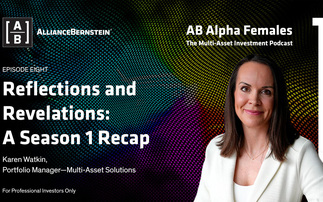
Shalin Shah and Martin Foden, RLAM
How do you define ABS investing?
Martin: I think since the financial crisis, the definition of Asset Backed Securities (ABS) has become narrowly focused on the securitisation market. However, our definition is broader and encompasses any security that has asset backing to support the interest payments and realisation of principal.
As a result, we invest across secured corporate bonds blended with securitisations to utilise the best of both worlds. Our Diversified ABS Fund is the purest form of that and will have the highest allocation to ABS bonds, covering both those asset classes.
What do you look for when investing in ABS?
Shalin: We look to harness the significant inefficiencies we have noticed in the credit markets. For instance, a typical corporate bond fund index is largely an unsecured index.
Based on our experience, by looking wider you can embed secured bonds into a fund without necessarily sacrificing yield. That's because rating agencies, which remain the key determinant of credit allocations in the market, typically focus on more limited aspects of creditworthiness, such as probability of default, rather than looking at how much money is returned in the case of a default. This means you can often pick up additional yield without compromising on downside protection.
Martin: With the right approach and focus we can find higher yielding bonds where not only do we have that secured claim on assets, but also strong covenants that provide more dynamic protection (before default). For instance, we can lend so that if at any point the value of collateral drops below a certain trigger level, the company will be required to put more assets into that position to enhance our clients' lending position.
We don't have a perfect crystal ball and by building in these pre-emptive controls, we materially improve control over companies we lend to, giving visibility of how that credit will evolve over different economic, corporate, and management cycles.
Can you take comfort from credit ratings within the higher-rated securitisations?
Martin: There are some very clear latent risks within securitisations that investors must be aware of as economic conditions deteriorate. Certain superficial characteristics that may be sought don't really provide any downside protection at all. You can buy an investment grade securitisation, but the fundamental reality is that unless you buy the senior AAA tranche, which often doesn't meet the yield requirements of dedicated ABS funds, you're buying a subordinated junior part of that capital structure. The reality is because borrowers are trying to maximise their leverage and minimise their cost, the first senior piece tends to be very large. So, you are not only subordinated, you are very subordinated. As securitised asset values start to fall, junior tranches can go from full recovery to full loss in the blink of an eye. Given typical ABS funds' yield targets, it's not unusual for them to have more than 50% of their exposures across these subordinated bonds. Our more diversified approach, embracing the inefficiencies across sectors, allows us to stay senior, minimising this subordination risk.
Shalin: There is concentration risk as well. A lot of these securitisations are concentrated on the consumer; so that's credit cards, automobiles, and residential mortgage-backed securities. When you look at those three key areas within the specialist ABS funds out there, the big issue is that a lot of the underlying consumers might be unable to meet their obligations - this is especially true with the present cost of living crisis. As a result, despite potentially looking like a diversified portfolio, many funds are actually just different iterations of consumer finance.
Extension risk in junior bonds is also significant. There is a perception that securitisations are short-dated but if bonds pass their expected maturity date, which is starting to happen, there will be an extension that can last years. The market reaction to this can be quite severe as credit exposure increases at the worst possible time. From an investor standpoint, they may think they're getting a high yield, but the reality is the achieved yield may be much lower should these bonds not mature at that first expected call.
It's a different outcome for secured corporate bonds with hard maturities and cash flow schedules and for the senior securitisation positions, where cash tends to get diverted if deals aren't called. These products provide much greater security and cash flow clarity as you're the first claim on assets.
Martin: The critical point is securitisations have very specific characteristics and the headlines don't always give you a true reflection of the underlying risks. It is critical that you are able to maintain selectivity; by taking a diversified approach you don't have to buy every deal and you don't have to be down the capital structure to achieve a certain portfolio yield.
How do you undertake ESG (Environmental, Social, Governance) analysis for ABS?
Martin: The short answer is ESG integration within the ABS area is no different to our ESG integration within the wider sterling credit approach. Anything that will undermine sustainability of cash flows or balance sheets, we must be aware of within our evaluations.
The challenge, but equally the opportunity, is that external data isn't great. Off-the-shelf scores, ratings and labels don't tend to handle ESG nuance particularly well so it's hard to delegate that to third party systems. We have a really experienced and effective in-house responsible investment team that collaborate with our analysts to enhance our risk identification.
Shalin: Our focus on control in lending also allows us to dampen the impact of poor management. In fact, one of the key reasons we build portfolios around secured bonds is for an enhanced governance structure and the benefit that control brings to advancing our ESG priorities too.
The value of investments and the income from them is not guaranteed and may go down as well as up. Investors may not get back the amount originally invested.
Find out more about RLAM's range of solutions at www.rlam.com
This post is funded by Royal London Asset Management
For professional clients only, not suitable for retail clients.
This is a financial promotion and is not investment advice. The views expressed are those of the authors at the date of publication unless otherwise indicated, which are subject to change.
The Fund is a sub-fund of Royal London Bond Funds ICVC, an open-ended investment company with variable capital with segregated liability between sub-funds, incorporated in England and Wales under registered number IC000797. The Company is a UCITS umbrella fund. The Authorised Corporate Director (ACD) is Royal London Unit Trust Managers Limited, authorised and regulated by the Financial Conduct Authority, with firm reference number 144037.
For more information on the fund or the risks of investing, please refer to the Prospectus or Key Investor Information Document (KIID), available via the relevant Fund Information page on www.rlam.com
Issued in December 2022 by Royal London Asset Management Limited, 55 Gracechurch Street, London, EC3V 0RL. Authorised and regulated by the Financial Conduct Authority, firm reference number 141665. A subsidiary of The Royal London Mutual Insurance Society Limited.





